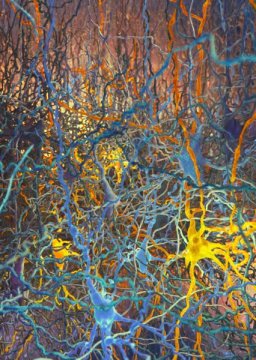[ad_1]
New research explains how the shapes of neurons can be classified using mathematical methods from the field of algebraic topology. Neuroscientists can now start building a formal catalogue for all the types of cells in the brain. Onto this catalogue of cells, they can systematically map the function and role in disease of each type of neuron in the brain.
“For nearly 100 years, scientists have been trying to name cells. They have been describing them in the same way that Darwin described animals and trees. Now the Blue Brain Project has developed a mathematical algorithm to objectively classify the shapes of the neurons in the brain,” explains Professor Henry Markram, Blue Brain’s Founder and Director. “This will allow the development of a standardized taxonomy [classification of cells into distinct groups] of all cells in the brain, which will help researchers compare their data in a more reliable manner.”
The team, with lead scientist Lida Kanari, have developed an algorithm to distinguish the different shapes of the most common type of neuron in the neocortex — the pyramidal cells. Pyramidal cells are distinctively tree-like cells that make up 80% of the neurons in the neocortex and, like antennas, collect information from other neurons in the brain. Basically, they are the redwoods of the forests of trees in the brain. They are excitatory, sending waves of electrical activity through the network, as we perceive, act, and feel.
The father of modern neuroscience, Ramón y Cajal, first drew pyramidal cells over 100 years ago, by looking at them under a microscope. Yet, up until now, scientists have not reached a consensus on the types of pyramidal neurons. Anatomists have been assigning names and debating the different types for the past century, while neuroscience has been unable to tell for sure which types of neurons are subjectively characterized. Even for visibly distinguishable neurons, there is no common ground to consistently define morphological types.
Seventeen types of pyramidal cells
The study from Blue Brain proves for the first time that objective classification of these pyramidal cells is possible, by applying tools from algebraic topology, the branch of mathematics that studies the shape, connectivity, and the emergence of global structure from local constraints.
Blue Brain has pioneered the use of algebraic topology to tackle a wide range of neuroscience problems, and with this study has once again demonstrated its effectiveness. In collaboration with Professors Kathryn Hess at EPFL and Ran Levi from the University of Aberdeen, Blue Brain developed an algorithm, which they then used to objectively classify seventeen types of pyramidal cells in the rat somatosensory cortex. The topological classification does not require expert input, and is proven to be robust.
The structure of most neurons resembles a complex tree, with multiple branches connecting to other neurons and communicating via electrical signals. If we keep the longest (persistent) components of the neuron structure and decompose the smaller branches, we can transform its tree-like structure into a barcode — a mathematical object that can be used as input for any machine-learning algorithm that will classify the neurons into distinct groups.
“Species” of brain cells
Any neuron classification process is plagued by this question: are two cells that look different just part of a continuum of gradually changing differences (like different “strains” of a species, e.g. different types of dogs) or are they really different “species” of neurons (e.g. dogs, cats, elephants, etc.)? In other words, are they discrete or continuous morphological variations of each other? This can be answered by using the new topological classification and grouping the different “species” of brain cells, each with its own characteristic “strains.”
“The Blue Brain Project is digitally reconstructing and simulating the brain, and this research provides one of the solid foundations needed to put all the types of neurons together,” explains Kanari. “By removing the ambiguity of cell types, the process of identifying the morphological type of new cells will become fully automated.”
This breakthrough can benefit the entire neuroscience community, as it will provide a more sophisticated understanding of cell taxonomy, and a reliable comparative method. The objective definition of morphological types is an essential first step towards a better understanding of the brain’s basic building blocks: how their structure is related to their function, and how local properties of neurons are connected to their long-range projections. This method provides a universal descriptor of trees, meaning that it can be used for the consistent description of all cell types in the brain, including neurons of all brain regions and glia cells.
[ad_2]















